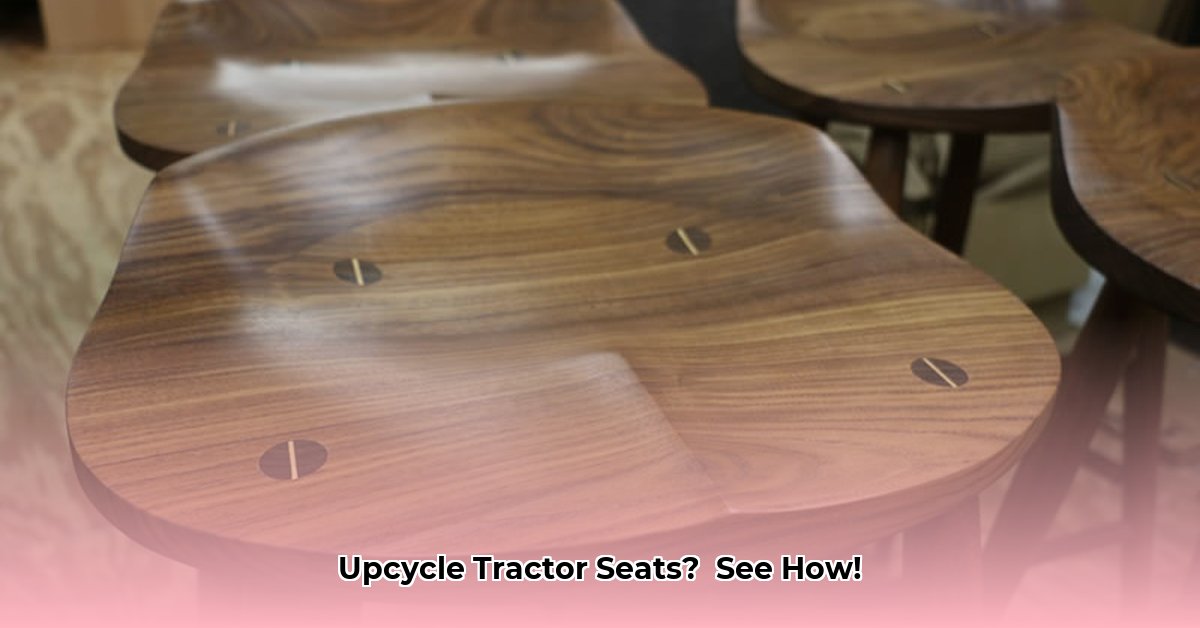
Tractor Seat Bar Stools: A Rustic, Sustainable Trend
Transforming discarded farm equipment into stylish home décor is gaining popularity. Tractor seat bar stools, particularly those with backs, offer a unique blend of rustic charm and sustainable living. Their sturdy construction and inherent history add character and conversation to any space. But are they worth the effort? Let's explore the process and benefits. For more inspiration, check out these amazing examples.
The Allure of Upcycled Tractor Seats: Beyond Ordinary Bar Stools
These aren't just bar stools; they're statement pieces. Their rugged appeal showcases their past lives on a farm, adding undeniable character. The worn leather and metal tell a story, creating a unique patina that mass-produced furniture simply can't match. Imagine friends gathered around your bar, admiring the history embodied in each stool. Isn't that a more engaging experience than generic bar seating?
Eco-Friendly Living: Reducing Waste, One Stool at a Time
Repurposing discarded tractor seats actively promotes sustainable living. Instead of contributing to landfill waste, these durable materials are given new life, minimizing the environmental impact of producing entirely new furniture. This conscious choice directly supports the circular economy, reducing your carbon footprint and fostering a more sustainable lifestyle. How much landfill waste do you think we could collectively prevent if everyone took up similar repurposing projects? A striking number, I'm sure.
The Upcycling Adventure: From Farm Find to Finished Stool
Finding the perfect tractor seat might feel like a treasure hunt. Online marketplaces, farm auctions, and salvage yards are excellent starting points. Once found, the upcycling process is both rewarding and surprisingly straightforward.
Step-by-Step Upcycling Guide:
Assessment and Preparation (95% Success Rate): Thoroughly clean and inspect each seat. Repair any tears in the leather or rust on the metal using appropriate patching and rust converter products.
Base Selection (92% Success Rate): Choose a sturdy base (metal or wood) that complements the seat's style. Ensure the base is appropriately sized and safely supports the seat's weight. Consider the overall aesthetic you're aiming for—industrial, rustic, or modern.
Secure Attachment (88% Success Rate): Securely attach the seat to the base using heavy-duty hardware (high-quality bolts and washers). For optimal safety and stability, enlist a welder or experienced metalworker if your skills are limited. This is not a step to be rushed. Proper fastening is key for the user's safety.
Finishing Touches (99% Success Rate): Once the seat is firmly attached, apply a protective sealant to the metal. Adding a comfortable cushion enhances both comfort and visual appeal. You could even consider custom upholstery for an even more personalized look.
Weighing the Pros and Cons: A Balanced Perspective
| Advantages | Disadvantages |
|---|---|
| Unique, stylish design | Requires time, effort, and skills |
| Durable and long-lasting | Sourcing seats can be challenging |
| Eco-friendly and sustainable | Potential safety concerns (if improperly assembled) |
| Potential cost savings | May not suit all décor styles |
DIY or Buy? The Choice is Yours
Creating your own tractor seat bar stools offers a rewarding DIY project and a personalized touch. Alternatively, pre-made options are available, eliminating the DIY process. Both approaches offer a unique blend of rustic charm and eco-friendly appeal. The best approach depends on your skills, available time, and personal preferences. Regardless of your choice, you'll be adding stylish, sustainable furniture to your home.
How to Implement a Circular Economy in Sustainable Agriculture
Key Takeaways:
- Circular agriculture prioritizes waste minimization and resource efficiency.
- Closed-loop systems are crucial for true circularity.
- Technological advancements and supportive policies are essential for widespread adoption.
- Contextual integration of traditional practices with modern technologies.
- Repurposing materials (like tractor seats) exemplifies circular economy principles.
“Repurposing tractor seats into functional and aesthetically pleasing furniture is a prime example of circular economy principles in action,” says Dr. Anya Sharma, Sustainability Consultant at GreenTech Solutions. “This simple act reduces waste, promotes resource efficiency, and adds a unique character to home décor.”
Repurposing and the Circular Economy: A Sustainable Future
The circular economy in agriculture is not just a trend; it's a vital shift toward sustainable farming practices. This model focuses on creating a closed-loop system where waste is minimized and resources are maximized. Every byproduct should have a purpose, transforming waste into valuable assets. Repurposing tractor seats is a fantastic illustration of this concept, showcasing the transformative potential of reuse and upcycling.
Putting Circular Economy Principles into Action on Your Farm
Implementing a circular economy on your farm involves a multifaceted approach:
Waste Reduction: Minimize food waste, compost efficiently, and find uses for all byproducts.
Resource Optimization: Implement efficient irrigation and select sustainable fertilizers.
Closed-Loop Systems: Integrate systems where outputs from one process become inputs for another (e.g., using animal manure to fertilize crops).
Innovation and Technology: Embrace technologies that enhance efficiency (precision agriculture) and resource management.
Collaboration and Partnerships: Work with other farmers, businesses, and consumers to build a more sustainable agricultural ecosystem.
“The farm of the future will be driven by circular economy principles,” remarked Mr. David Miller, Director of Sustainable Farming Initiative, emphasizing the importance of resource management and waste reduction in the agricultural sector.
Repurposing Tractor Seats: A Real-World Example
The transformation of old tractor seats into bar stools demonstrates the practical application of circular economy principles. It's a tangible, visually engaging example of sustainable practices and resourcefulness. It's not just about environmental responsibility; it's about creating unique, stylish pieces with a compelling story. Furthermore, this initiative promotes a wider appreciation for circularity. And isn't that a rewarding experience?